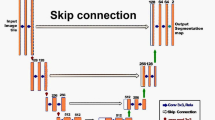Abstract
Lung cancer is an abnormal development of cells that are uncontrollably proliferating. When using a system for medical diagnostics, the precise identification of lung cancer is crucial. Magnetic Resonance Imaging (MRI) and Positron Emission Tomography (PET) are the most common methods for diagnoses. Due to the limited sensitivity of the border pixels in PET and MRI imaging, finding lung cancer might be difficult. As a result, image fusion was created, which successfully combines several modalities to identify the disease and cure it. But merging images from multiple modalities has always been troublesome in medicine because the final image includes distorted spectral information. To avoid the problems, in this paper,pixel level image fusion for lung cancer detection is proposed. Pre-processing, multi-modality image fusion, feature extraction, and classification are the four phases of the suggested methodology. Images from the PET and MRI scanners are initially gathered and pre-processed. The best pixel-level fusion method is then used to merge the PET and MRI images. Here, the adaptive tee seed optimization (ATSO) method is used to ideally choose the fusion parameter contained in the approach to improve the fusion model. The texture characteristics are taken from the fused image after the image fusion. The deep extreme learning machine (DELM) classifier will then identify animage as normal or abnormal using the retrieved features.Utilizing a variety of criteria, the effectiveness of the suggested methodology is assessed and compared to previous state-of-art studies. The experimental results shows proposed approach attained the maximum accuracy of 97.23%.













Similar content being viewed by others
Data availability
Data sharing not applicable to this article as no datasets were generated or analysed during the current study.
Code availability
Code is available.
References
Cassim S, Kidd J, Rolleston A, Keenan R, Aitken D, Firth M, Middleton K, Chepulis L, Wong J, Hokowhitu B, Lawrenson R (2021) Hā Ora: Barriers and enablers to early diagnosis of lung cancer in primary healthcare for Māori communities. Eur J Cancer Care 30(2):e13380
MacLean A, Hunt K, Smith S, Wyke S (2017) Does gender matter? An analysis of men’s and women’s accounts of responding to symptoms of lung cancer. Soc Sci Med 191:134–142
Wielpütz M, Kauczor HU (2012) MRI of the lung: state of the art. Diagn Interv Radiol 18(4):344–353
Mansoor A, Bagci U, Foster B, Xu Z, Papadakis GZ, Folio LR, Udupa JK, Mollura DJ (2015) Segmentation and image analysis of abnormal lungs at CT: current approaches, challenges, and future trends. Radiographics 35(4):1056
Kaur H, Koundal D, Kadyan V (2021) Image fusion techniques: a survey. Arch Computational Methods Eng 28(7):4425–4447
Li S, Kang X, Fang L, Hu J, Yin H (2017) Pixel-level image fusion: A survey of the state of the art. Information Fusion 33:100–112. https://doi.org/10.1016/j.inffus.2016.05.004
Razzak, MI, Naz, S, Zaib, A (2018) Deep learning for medical image processing: Overview, challenges and the future. Classification in BioApps, pp.323–350. https://doi.org/10.1007/978-3-319-65981-7_12
Kiran MS (2015) TSA: Tree-seed algorithm for continuous optimization. Expert Syst Appl 42(19):6686–6698
Uzair M, Shafait F, Ghanem B, Mian A (2018) Representation learning with deep extreme learning machines for efficient image set classification. Neural Comput Appl 30(4):1211–1223
Asuntha A, Srinivasan A (2020) Deep learning for lung Cancer detection and classification. Multimed Tools Appl 79(11):7731–7762
Jena SR, George ST, Ponraj DN (2021) Lung cancer detection and classification with DGMM-RBCNN technique. Neural Comput Appl 33(22):15601–15617
Guo Z, Xu L, Si Y, Razmjooy N (2021) Novel computer-aided lung cancer detection based on convolutional neural network-based and feature-based classifiers using metaheuristics. Int J Imaging Syst Technol 31(4):1954–1969
Akter O, Moni MA, Islam MM, Quinn JM, Kamal AHM (2021) Lung cancer detection using enhanced segmentation accuracy. Appl Intell 51(6):3391–3404
Parvathy VS, Pothiraj S (2020) Multi-modality medical image fusion using hybridization of binary crow search optimization. Health Care Manag Sci 23(4):661–669
Wang Z, Li X, Duan H, Su Y, Zhang X, Guan X (2021) Medical image fusion based on convolutional neural networks and non-subsampled contourlet transform. Expert Syst Appl 171:114574
Fu J, Li W, Ouyang A, He B (2021) Multimodal biomedical image fusion method via rolling guidance filter and deep convolutional neural networks. Optik 237:166726
Lewis J, O’Callaghan R, Nikolov S, Bull D, Canagarajah N (2007) Pixel- and region based image fusion with complex wavelets. Information Fusion 8(2):119–130
Petrovic VS, Xydeas CS (2004) Gradient-based multiresolution image fusion. IEEE Trans Image Process 13(2):228–237
Funding
The authors declare that they have competing interests and funding.
Author information
Authors and Affiliations
Contributions
All authors read and approved the final manuscript.
Corresponding author
Ethics declarations
Conflict of interests
On behalf of all authors, the corresponding author states that there is no conflict of interest.
Additional information
Publisher's Note
Springer Nature remains neutral with regard to jurisdictional claims in published maps and institutional affiliations.
Rights and permissions
Springer Nature or its licensor (e.g. a society or other partner) holds exclusive rights to this article under a publishing agreement with the author(s) or other rightsholder(s); author self-archiving of the accepted manuscript version of this article is solely governed by the terms of such publishing agreement and applicable law.
About this article
Cite this article
Nair, L.V., Jerome, S.A. Optimized pixel level image fusion for lung cancer detection over MRI and pet image. Multimed Tools Appl (2024). https://doi.org/10.1007/s11042-024-19034-w
Received:
Revised:
Accepted:
Published:
DOI: https://doi.org/10.1007/s11042-024-19034-w




